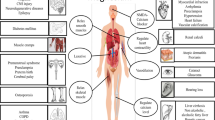Abstract
The purpose of this study is to explore more trace elements (zinc, potassium, copper, iron, boron, manganese, selenium, chromium and cadmium elements) in addition to calcium, magnesium, lead and arsenic in the sera of patients with schizophrenia and the general population in China and to determine the effect of selenium on schizophrenia patients. Participants were collected from the Pingyin County Mental Health Hospital and Pingyin County. A t test was used to analyse the differences between schizophrenia patients and healthy subjects, and element content differences in gender. Logistic multivariate regression analysis was applied to analyse the influence of elements to schizophrenia. Repeated measures analysis of variance was used to analyse differences in the elements after 1 and 3 months. Mn, Se, Cd, Pb, Ca, Cu and Fe were lower than those in the normal group, and B, Cr, As, K and Mg were higher than those in the control group. The odd ratios (ORs) of serum As and serum K were 2.624 and 1.035, respectively. The ORs of sera Cr, Mn, Se, Ca and Cu were all below one. After intervention of ‘selenium weikang’ about 1 and 3 months, the serum As was decreased and the serum selenium and copper were increased. Cr, Mn, Se, Ca and Cu might have beneficial, statistically significant effects on schizophrenia. Elements As and K might be harmful to schizophrenia with statistical significance. After selenium supplementation, the schizophrenia patients improved in some factors, like the appetite and memory, and the As element decreased.
Similar content being viewed by others
References
Mertz W (1981) The essential trace elements. Science 213(4514):1332–1338
Fraga CG (2005) Relevance, essentiality and toxicity of trace elements in human health. Mol Asp Med 26(4–5):235–244. doi:10.1016/j.mam.2005.07.013
Hegde ML, Shanmugavelu P, Vengamma B, Rao TSS, Menon RB, Rao RV, Rao KSJ (2004) Serum trace element levels and the complexity of inter-element relations in patients with Parkinson’s disease. J Trace Elem Med Biol 18(2):163–171. doi:10.1016/j.jtemb.2004.09.003
Liu T, Lu QB, Yan L, Guo J, Feng F, Qiu J, Wang J (2015) Comparative study on serum levels of 10 trace elements in schizophrenia. PLoS One 10(7):e0133622. doi:10.1371/journal.pone.0133622
Mueser KT, Mcgurk SR (2010) Schizophrenia. Lancet 363(9426):2063–2072
Frangou S (2008) Schizophrenia. Medicine 36(8):405–409
Xiang YT, Ma X, Cai ZJ, Li SR, Xiang YQ, Guo HL, Hou YZ, Li ZB, Li ZJ, Tao YF (2008) Prevalence and socio-demographic correlates of schizophrenia in Beijing, China. Schizophr Res 102(1–3):270–277. doi:10.1016/j.schres.2008.04.009
Alimonti A, Ristori G, Giubilei F, Stazi MA, Pino A, Visconti A, Brescianini S, Sepe MM, Forte G, Stanzione P (2007) Serum chemical elements and oxidative status in Alzheimer’s disease, Parkinson disease and multiple sclerosis. Neurotoxicology 28(3):450–456. doi:10.1016/j.neuro.2006.12.001
Rahman MA, Azad MAK, Hossain MI, Qusar MMAS, Bari W, Begum F, Huq SMI, Hasnat A (2009) Zinc, manganese, calcium, copper, and cadmium level in scalp hair samples of schizophrenic patients. Biol Trace Elem Res 127(2):102–108. doi:10.1007/s12011-008-8230-8
Sørensen HJ, Nielsen PR, Pedersen CB, Mortensen PB (2011) Association between prepartum maternal iron deficiency and offspring risk of schizophrenia: population-based cohort study with linkage of Danish national registers. Schizophr Bull 37(5):982–987. doi:10.1093/schbul/sbp167
Nava-Ruíz C, Méndez-Armenta M (2011) Neurotoxic effects of heavy metals cadmium, lead arsenic and thallium. Archivos Neurociencias 16(3):140–147
Vidović B, Đorđević B, Milovanović S, Škrivanj S, Pavlović Z, Stefanović A, Kotur-Stevuljević J (2013) Selenium, zinc, and copper plasma levels in patients with schizophrenia: relationship with metabolic risk factors. Biol Trace Elem Res 156(1–3):22–28. doi:10.1007/s12011-013-9842-1
Cai L, Chen T, Yang J, Zhou K, Yan X, Chen W, Sun L, Li L, Qin S, Wang P (2015) Serum trace element differences between schizophrenia patients and controls in the Han Chinese population. Sci Rep 5:15013. doi:10.1038/srep15013
Meramat A, Rajab NF, Shahar S, Sharif R (2015) Cognitive impairment, genomic instability and trace elements. J Nutr Health Aging 19(1):48–57. doi:10.1007/s12603-014-0489-1
Tyrer SP, Delves HT, Weller MP (1979) CSF copper in schizophrenia. Am J Psychiatr 136(7):937–939. doi:10.1176/ajp.136.7.937
Gambling L, Kennedy C, Mcardle HJ (2011) Iron and copper in fetal development. Semin Cell Dev Biol 22(6):637–644. doi:10.1016/j.semcdb.2011.08.011
Lin T, Liu T, Lin Y, Yan L, Chen Z, Wang J (2017) Comparative study on serum levels of macro and trace elements in schizophrenia based on supervised learning methods. J Trace Elem Med Biol. doi:10.1016/j.jtemb.2017.03.010
Lidow MS (2003) Calcium signaling dysfunction in schizophrenia: a unifying approach. Brain Res Rev 43(1):70–84. doi:10.1016/S0165-0173(03)00203-0
Castro MRD, Lima JV, Freitas DPSD, Valente RDS, Dummer NS, Aguiar RBD, Santos LCD, Marins LF, Geracitano LA, Monserrat JM (2009) Behavioral and neurotoxic effects of arsenic exposure in zebrafish (Danio rerio, Teleostei: Cyprinidae). Comp Biochem Physiol C Toxicol Pharmacol 150(3):337–342
Grandjean P, Herz KT (2015) Trace elements as paradigms of developmental neurotoxicants: lead, methylmercury and arsenic. J Trace Elem Med Biol 31:130–134. doi:10.1016/j.jtemb.2014.07.023
Vaddadi KS, Soosai E, Vaddadi G (2003) Low blood selenium concentrations in schizophrenic patients on clozapine. Br J Clin Pharmacol 55(3):307–309. doi:10.1046/j.1365-2125.2003.01773.x
Lee SY, Lee SJ, Han C, Patkar AA, Masand PS, Pae CU (2013) Oxidative/nitrosative stress and antidepressants: targets for novel antidepressants. Prog Neuro-Psychopharmacol Biol Psychiatry 46:224–235
Roman M, Jitaru P, Barbante C (2014) Selenium biochemistry and its role for human health. Metallomics 6(1):25–54. doi:10.1016/j.pnpbp.2012.09.008
Bauer M, Goetz T, Glenn T, Whybrow PC (2008) The thyroid-brain interaction in thyroid disorders and mood disorders. J Neuroendocrinol 20(10):1101–1114. doi:10.1111/j.1365-2826.2008.01774.x
Berry T (1993) Selenium deficiency and clinical findings in schizophrenia: a common thread. J Orthomol Med 8(1):21–24
Pitts MW, Raman AV, Berry MJ (2012) Schizophrenia, oxidative stress and selenium. In: Hatfield DL, Berry MJ, Gladyshev VN (eds) Selenium: its molecular biology and role in human health. Springer New York, New York, pp 355–367. doi:10.1007/978-1-4614-1025-6_28
Sharma SK, Sharma A, Sood S, Gupta ID (2014) Study of serum selenium levels in schizophrenic patients. Scand J Clin Lab Investig 62(1):59–68
Author information
Authors and Affiliations
Corresponding author
Rights and permissions
About this article
Cite this article
Li, Z., Liu, Y., Li, X. et al. Association of Elements with Schizophrenia and Intervention of Selenium Supplements. Biol Trace Elem Res 183, 16–21 (2018). https://doi.org/10.1007/s12011-017-1105-0
Received:
Accepted:
Published:
Issue Date:
DOI: https://doi.org/10.1007/s12011-017-1105-0




